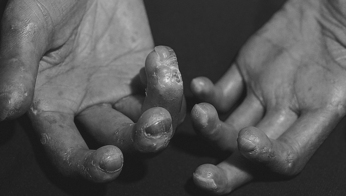77. Scleroderma
Definition
“Scleroderma” literally means “hard or thickened skin.” The disease is a multisystem disorder characterized by inflammation, tissue fibrosis, and microvascular occlusion as the result of excessive production and deposition of collagen types I and III. Characteristics of scleroderma are most obvious in the skin but also appear in the pulmonary, cardiovascular, renal, gastrointestinal, and genitourinary systems.
Incidence
Scleroderma is found worldwide. Frequency is estimated at 19:1,000,000. Women have a 3- to 8-fold greater risk for developing the disease, with the peak onset between 30 and 50 years of age.
Etiology
The exact cause of scleroderma remains unknown. There are proposed pathologic mechanisms, such as endothelial cell injury, activation of fibroblasts, cytomegalovirus (human herpesvirus 5), and immune system derangement. Proposed environmental causative factors for scleroderma include exposure to silica or solvents such as trichloroethylene, epoxy resins, benzene, or carbon tetrachloride. To date, none of these proposed mechanisms have been substantiated.
Signs and Symptoms
• Arthralgia
• Aspiration pneumonia
• Bloating
• Chest pain
• Chronic renal insufficiency
• Constipation alternating with diarrhea
• Diffuse pruritus
• Dyspareunia
• Dyspepsia
• Dysphagia
• Early satiety
• Erectile dysfunction
• Facial pain
• Fatigue
• Gastroesophageal reflux
• Hand paresthesias
• Headache
• Hoarseness
• Hyperpigmentation
• Hypopigmentation
• Hypothyroidism
• Incompetent lower esophageal sphincter
• Irregular heart rhythm
• Joint range of motion loss
• Muscle weakness
• Myalgia
• Palpitations
• Persistent dry cough
• Poor dentition
• Progressive dyspnea
• Pulmonary hypertension
• Raynaud phenomenon
• Renal crisis
• Sicca syndrome (see Sjögren syndrome, p. 316)
• Skin induration
• Skin tightness
• Stroke
• Syncope
• Weight loss
 |
| Scleroderma. Advanced systemic sclerosis. The extensive subcutaneous fibrosis has virtually immobilized the fingers, creating a clawlike flexion deformity. Loss of blood supply has led to cutaneous ulcerations. |
Medical Management
Currently, there is no FDA-approved treatment regimen specifically for scleroderma. Symptomatic or systematic treatments may be administered. No documented controlled studies have demonstrated a clear superiority of one treatment modality. The thickening of the patient’s skin is frequently treated with D-penicillamine or methotrexate. Moisturizers, histamine-1 and -2 blocking drugs, tricyclic antidepressants, or trazodone may be used to treat the associated pruritus.
Raynaud phenomenon may be treated with calcium-channel blockers, prazosin, dipyridamole, aspirin, and/or topical nitrates. Tissue plasminogen activator, heparin, or urokinase may be needed in the event of thrombus formation and/or compromise of vascular flow.
Histamine-2 (H 2)-blockers, antacids, proton pump inhibitors, prokinetic medications, and/or octreotide may be used to treat the gastrointestinal manifestations of scleroderma. The patient may also need to exercise reflux precautions, consume smaller, more frequent meals, and/or laxatives to treat the gastrointestinal symptoms.
Pulmonary manifestations include fibrosis and hypertension. Cyclophosphamide, given either orally or intravenously, may be used to treat the patient’s fibrosis. Pulmonary hypertension is initially treated with supplemental oxygen but may progress to the need for administration of bosentan in the most severe cases.
Corticosteroids, methotrexate, or azathioprine are generally used to treat the patient’s myositis. Corticosteroids are usually the first line of drugs for this symptom. The dosage of steroids can be increased but only with great caution because doses greater than 40 mg/day can precipitate scleroderma-induced renal crisis. Every effort should be made to prevent initiation of a renal crisis associated with scleroderma, whether from the disease or from treatment of associated myositis. Angiotensin-converting enzyme inhibitor agents must be aggressively used with the first indication of the development of hypertension. Arthralgias and myalgias associated with scleroderma are usually treated with mild analgesics, such as acetaminophen and/or one of the nonsteroidal anti-inflammatory drugs.
Surgical intervention usually involves a digital sympathectomy. This relatively extreme intervention is generally reserved for those patients exhibiting a severe form of Raynaud phenomenon and who experience an acute, unrelenting episode that threatens one or more digits. Severely ischemic and/or infected digital lesions may necessitate debridement or, in the worst-case scenario, amputation. Severe flexion contractures may require surgical release.
Complications
• Cardiac tamponade
• Coagulation disorders
• Congestive heart failure
• Cor pulmonale
• Digital infarctions
• Infection
• Intestinal hypomotility
• Malabsorption syndrome
• Myositis
• Pericardial effusion
• Pericarditis
• Pulmonary fibrosis
• Pulmonary hypertension
• Renal failure
• Stroke
Anesthesia Implications
The first concern for the anesthetist is, as always, airway and breathing. Because of the relative tightness/tautness of the skin, the patient may have a limited range of motion of the mandible, thus poor opening of the mouth. It may therefore be difficult to perform direct laryngoscopy for intubation. The tightness is not affected by the administration of muscle relaxants. As a result, it may be necessary to secure the patient’s airway via nasotracheal intubation, either blind or with the fiberoptic bronchoscope, or orally using the bronchoscope.
Skin manifestations of scleroderma are the most obvious, but pulmonary pathology from the disease is infinitely more complex and far reaching. Fibrotic pulmonary damage produces dramatic loss of lung compliance, resulting in restrictive pulmonary disease. The degree of the patient’s restrictive disease should be determined preoperatively with pulmonary function tests (PFTs). In addition, the patient’s lung function should be further evaluated by diffusion capacity testing and arterial blood gas sampling for analysis. The patient’s fibrosis and altered lung compliance drastically increase the work of breathing. General anesthesia with preservation of spontaneous breathing is not recommended for the patient with scleroderma; therefore the employment of the laryngeal mask airway should be avoided. Mechanical ventilation of the patient may be difficult, requiring higher-than-expected pressure to inflate the lungs. Loss of compliance also means that expiration is generally not as complete as normal, making barotrauma a very real possibility. The anesthetist must attempt to provide mechanical ventilation with the lowest possible peak inspiratory pressure while also providing a prolonged expiratory phase to reduce possible air trapping. Most of the more recent models of anesthesia machines allow for pressure-controlled ventilation, and the anesthetist should choose the lowest effective peak inspiratory pressure to provide good tidal volume and minute ventilation.
The patient with scleroderma should be evaluated for pulmonary hypertension by chest x-ray and electrocardiogram. Pulmonary hypertension heightens the patient’s vulnerability to developing hypoxemia. Supplemental oxygen is of paramount importance for the patient no matter the scope of the proposed surgical intervention or the intended anesthesia technique. For the patient who will receive general anesthesia, the period of preoxygenation should extend beyond the recommended, typically 5 minutes, possibly even double that amount of time, assuming the procedure is not truly emergent in nature. Preoperative sedation should be maintained at a minimum, if given at all, and should definitely not incorporate opioid analgesics because of the patient’s heightened vulnerability to develop hypoxemia. Intraoperatively, the anesthetist should not include nitrous oxide in the anesthetic plan because of the exacerbation of pulmonary hypertension that may result.
Before general anesthesia, the patient with scleroderma should receive pretreatment for gastroesophageal reflux using antacids and/or H 2-blockers to raise the pH of any gastric contents. Prokinetic agents may help promote gastric emptying before surgery and anesthesia. General anesthesia should be achieved via classic rapid sequence induction. At the end of anesthesia, the scleroderma patient should not be extubated until good laryngeal protective reflexes are demonstrated, whether in the operating room suite or in the post-anesthesia care unit.
Intravenous access may be difficult to obtain because of the toughness and thickness of the patient’s skin. Intravenous access takes on a greater importance in the patient with scleroderma. The patient usually develops systemic hypertension as well as vasomotor instability. As a result, the patient adapts to life in a state of chronically reduced intravascular volumes, thus a state of relative hemoconcentration. When intravenous access is obtained, preferably via large-bore catheters, the anesthetist should “front-load” the patient with intravenous fluids in a fashion similar to the fluid loading given in preparation for a regional anesthetic—providing the patient does not have a history or symptoms of congestive heart failure. The fluid load is intended to counteract the vasodilation produced by induction of general anesthesia.
Regional anesthesia is an appropriate technique for the patient with scleroderma, particularly those receiving total joint arthroplasty procedures. Insertion of the needle for administration of the regional anesthetic may be difficult because of the patient’s thick skin, but also because of changes in joint mobility produced by the scleroderma. There have been reports of prolonged action of local anesthetics in association with scleroderma, but the etiology and/or clinical significance (if any) have not been demonstrated.
Scleroderma can significantly alter kidney function and result in renal failure. The functionality of the kidneys should be assessed preoperatively. The anesthetist must temper anesthesia drug selection, as well as fluid resuscitation, in accordance with the results of the renal function testing.
The patient with scleroderma may exhibit Raynaud phenomenon as well as sicca syndrome. Both must be accommodated by the anesthetist. The Raynaud phenomenon should be addressed by warming of the ambient room temperature to about 70° F (21° C) administering warmed intravenous fluids, and using a forced-air warming blanket throughout even the shortest surgical procedure. Patients who exhibit a moderate to severe form of Raynaud phenomenon should not have their radial artery catheterized for perioperative blood pressure monitoring because of the heightened risk for digital ischemia. Sicca syndrome causes excessive dryness of mucous membranes. As a result, antisialagogues should be omitted from the patient’s premedication orders. In addition, it is imperative that the patient’s eyes be lubricated and well protected throughout the perioperative period.
Finally, malabsorption syndrome at times accompanies scleroderma as the result of gastrointestinal manifestations of the disease. Malabsorption can result in inadequate synthesis of proteins, such as critical enzymes or clotting factors, or albumin. Inadequate serum proteins can result in greater bioavailability of some anesthesia medications, for which the anesthetist may need to compensate by reducing the dose. In addition, clotting factors may not be produced in appropriate concentrations, in which case the anesthetist should be prepared for greater than normal blood loss for a given surgical procedure. It may be appropriate to order blood typing and screening even for seemingly minor operative procedures, for which such blood work would not normally be necessary.







